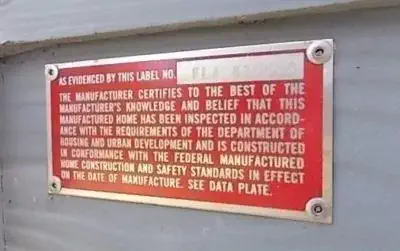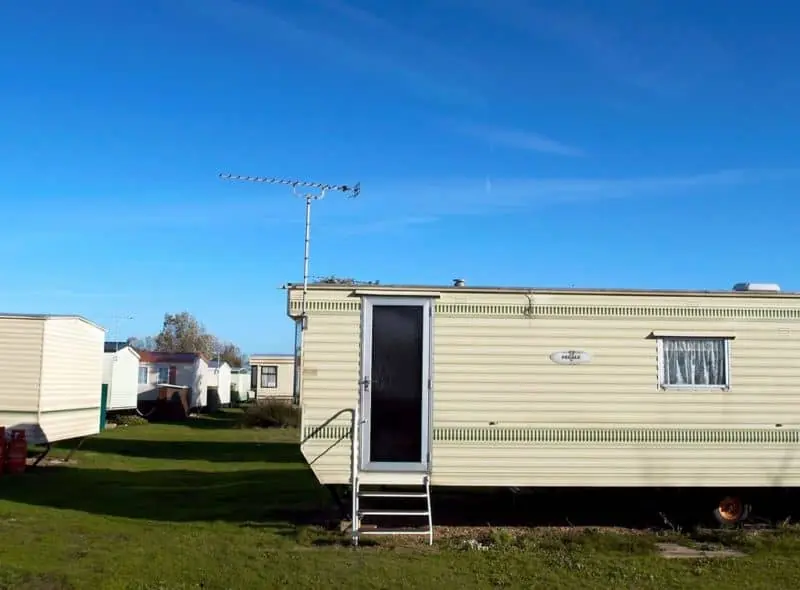According to federal manufactured home construction rules, any manufactured home should come with a data plate. This is a sheet from the manufacturer that provides standardized information at a glance about the manufactured home, such as when and where it was made and what kinds of equipment it includes. Typically, the data plate will be posted in a place where it’s easy to access and read: The closet of a master bedroom, the electrical panel and inside a kitchen cabinet are popular choices.
The Basics of a Manufactured Home Data Plate
 Anyone in the business of building manufactured homes will need to provide each unit they construct with a manufactured home data plate and the appropriate metal HUD tag (or tags).
Anyone in the business of building manufactured homes will need to provide each unit they construct with a manufactured home data plate and the appropriate metal HUD tag (or tags).
The information on a data plate is crucial for purchasers of a manufactured home. There are additional certifications required as well, such as the HUD tag that certifies the home has been manufactured according to the federal standards mandated by the Department of Housing and Urban Development (HUD).
A standard data plate should cover the following:
- The home’s manufacturer and their location
- Performance verification certificate numbers (also called HUD tag numbers, and these should also appear on an etched metal HUD label attached to the home) that identify the federal housing code that was in effect when the home was constructed
- The date of construction
- Serial and model numbers (also called a mobile home’s vehicle identification number or VIN)
- A factory-installed equipment table (this itemizes the major factory-installed equipment and appliances that came with the home along with their manufacturers and serial numbers)
- Roof load zone (the box checked here is meant to be cross-checked against a small adjacent map of the U.S. to confirm that the home has been built to account for the likely weight of snow in the installation location)
- Wind load zone (states are designated as zone I, II or III for the purpose of building to withstand different levels of extreme winds; again, cross-checking the designation with a small map will indicate whether the home is rated to withstand winds in the installation location)
- Comfort cooling (if air conditioning came factory-installed)
- A heating and cooling thermal map (indicates what temperature zone the manufactured home was designed for, with zone 1 being the warmest and zone III being the coldest)
Finally, the data plate will carry the information of the inspection agency that certified the manufactured home as being up to code. There are only a few such agencies, identified by specific codes, and they are required not to have any connection to the manufacturer.

How to Deal With a Lost or Missing Data Plate
It’s generally recommended that you protect your manufactured home’s data plate by all necessary means — it’s a necessity of financing, insuring, improving or selling the unit. If it’s posted in a cabinet that’s going to be renovated, for example, you’ll need to remove and reattach it well out of the way.
In the event a data plate does go missing, or simply becomes illegible over the course of time, you’ll need to reach out to the Institute for Building Technology and Safety (IBTS). This HUD subcontractor handles requests for missing manufactured home data plates, and getting a new one means contacting and paying them directly.
The base fee is $50 for a request that takes two to three weeks to process. An expedited request, processed in 2-3 days, is $100.
Dealing With a Lost or Missing HUD Tag
The HUD tag mentioned above, which is just as important for mobile or manufactured home financing or sale as the data plate, is a 2-inch by 4-inch metal plate. Its basic function is to verify that the unit passed inspection in keeping with federal housing codes when it was made.
These tags are made of metal and designed for external display, typically posted just above the bottom and near the back of each of the home’s sections. They carry a standard message:
“The manufacturer certifies to the best of the manufacturer’s knowledge and belief that this manufactured home has been inspected in accordance with the requirements of Department of Housing and Urban Development and is constructed in conformance with the federal manufactured home construction and safety standards in effect on the date of manufacture. See data plate.”
Each tag also carries a unique certification label number. Unlike with a data plate, there’s no easy way to reissue HUD tags if they go missing. However, the label numbers should also appear on the home’s data plate, and you can reinforce this by seeking a Letter of Label Verification from the IBTS.
Wrap-Up
Anyone buying a used mobile or manufactured home, or looking to sell one, needs to pay careful attention to the presence and legibility of its data plate and HUD tags. These are the most basic tools provided to show certification and compliance with federal housing codes.
If you’re a buyer, be sure to check and make sure that the data plate is easy to find and read and that HUD tags are posted where they should be. If these things are missing, it won’t be possible to transfer the title to your new unit or get financing for it. Be sure to give yourself plenty of lead time in case one of these articles should turn up missing so you don’t find yourself racing the clock to get replacement certification or verification letters.